Abstract
A comparative study of the inhibitory effect of Atabrine on R− and R+ strains of Escherichia coli showed that R+ cells were killed when grown in the presence of Atabrine, whereas R− cells were not. It would appear, therefore, that R factor confers sensitivity to Atabrine on the host cells. The “curing” of R factor from R+ cells by the ultraviolet light-acridine orange method rendered the “cured” cells more resistant than even the parent R− cells. The “cured” cells reinfected by R factor were more sensitive than the “cured” cells but less sensitive than the original R+ cells. After growth once in Atabrine, and even after subcultures in drug-free medium, the growth of R+ cells in the presence of Atabrine was more rapid than that of the R− cells. R− cells made resistant by growing them repeatedly in streptomycin, chloramphenicol, tetracycline, and sulfathiazole in succession also showed a higher degree of sensitivity to Atabrine than the original R− cells. When mixtures of R− and R+ cells were grown in 120 μg/ml of Atabrine, R+ cells were killed and the culture consisted predominantly of R− cells. A mixture of R− and R+ cells (1:10,000) inoculated into the Atabrine-containing medium and treated 24 hr later with chloramphenicol was completely killed.
Full text
PDF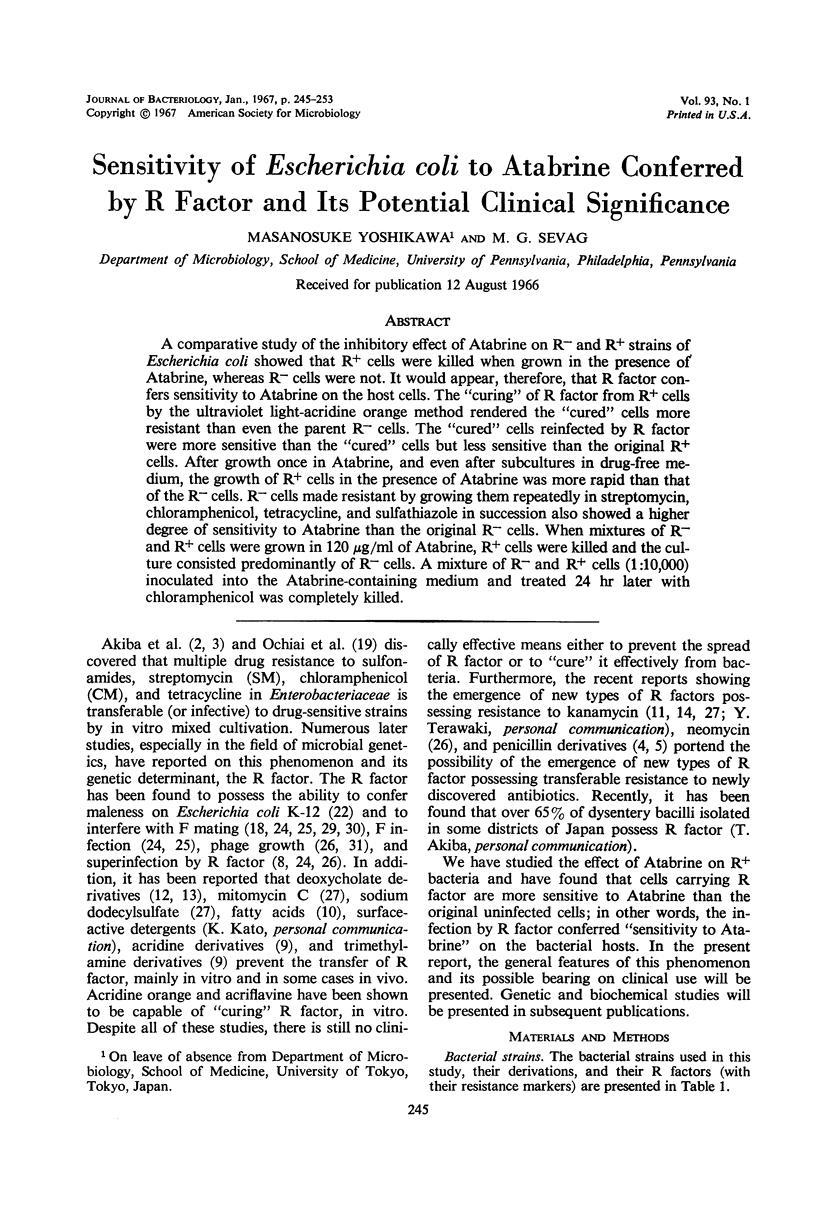

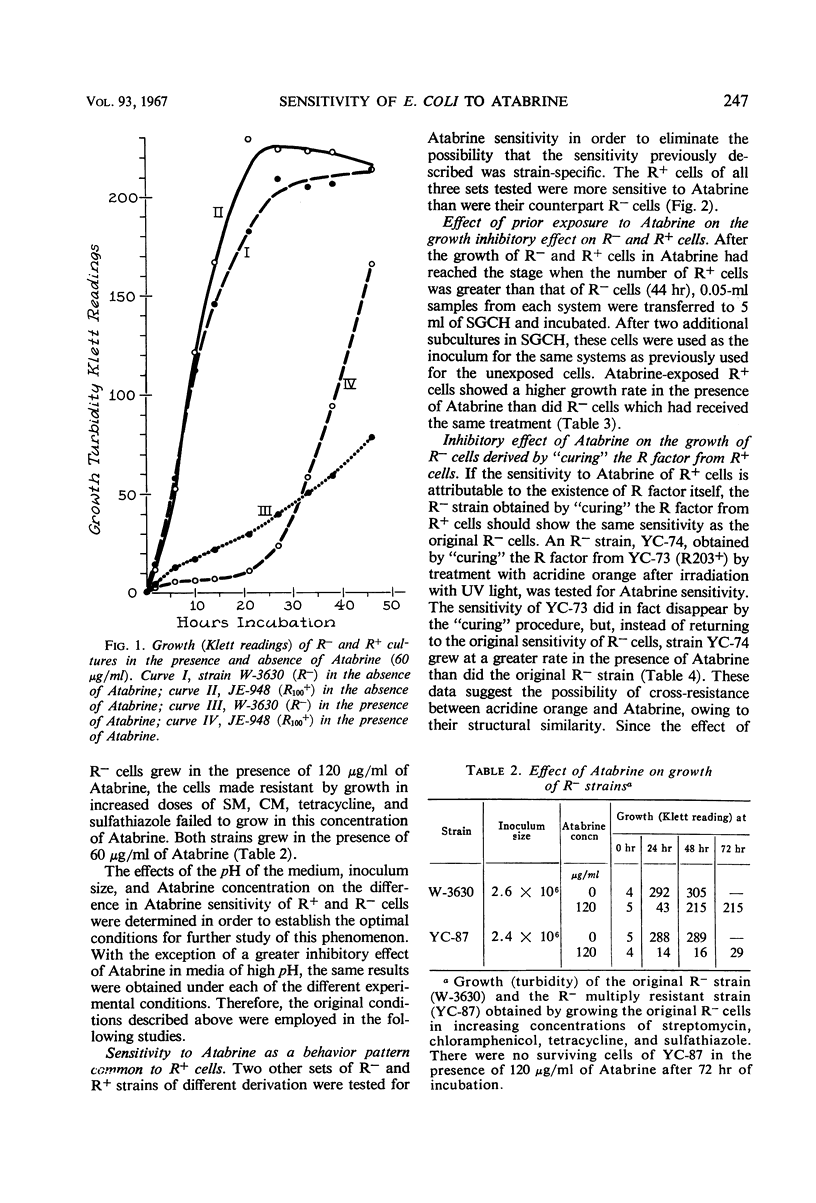

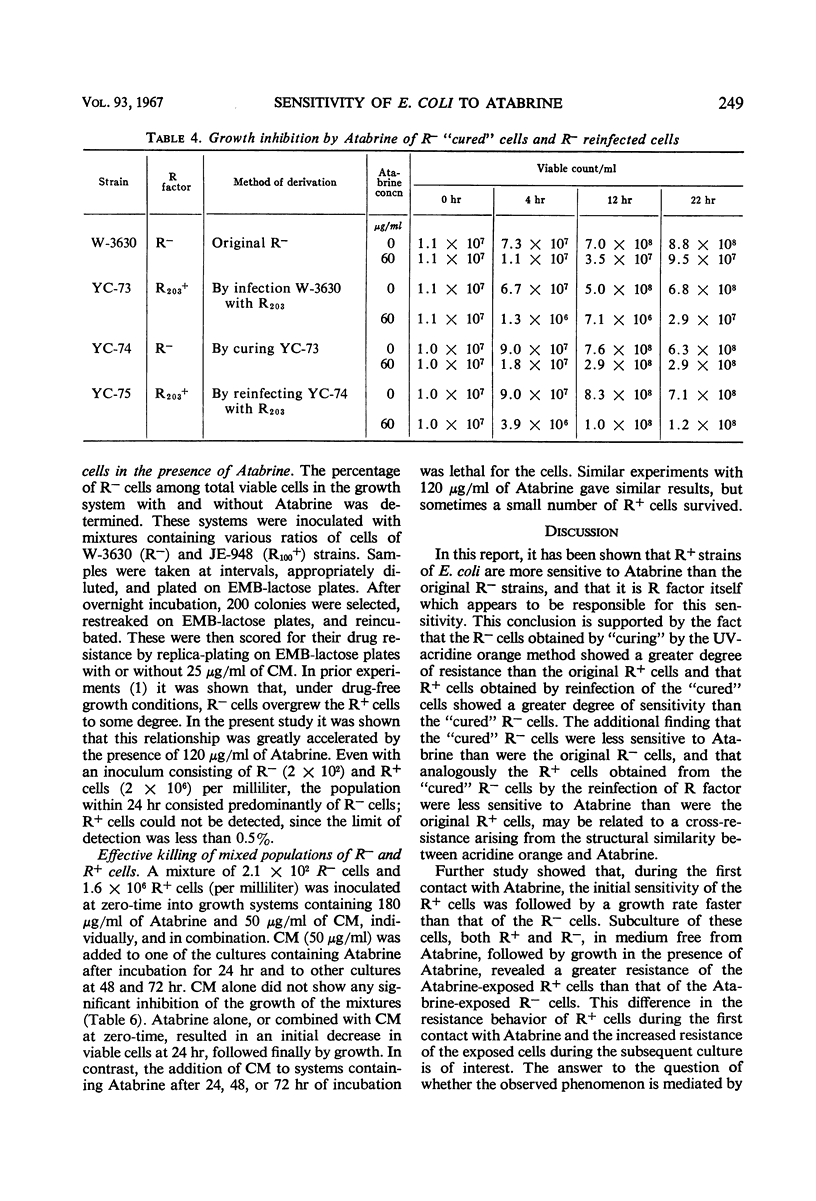

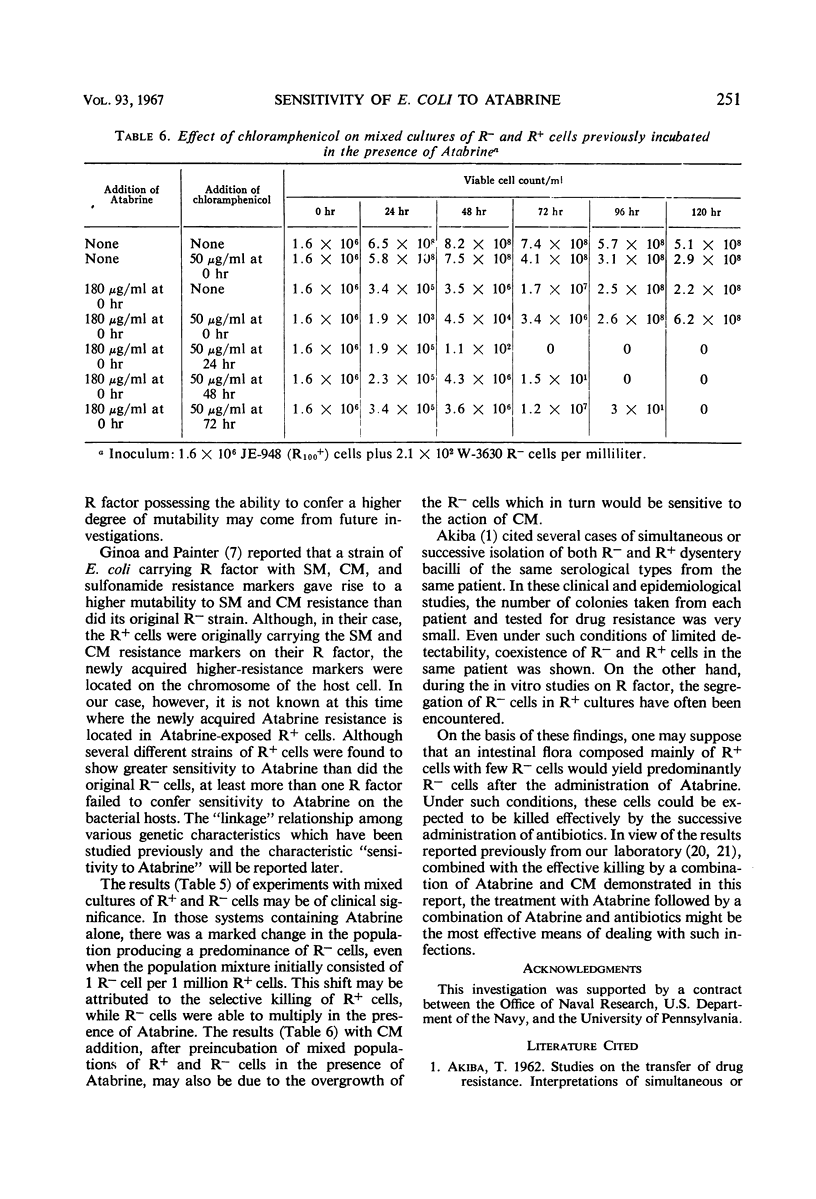
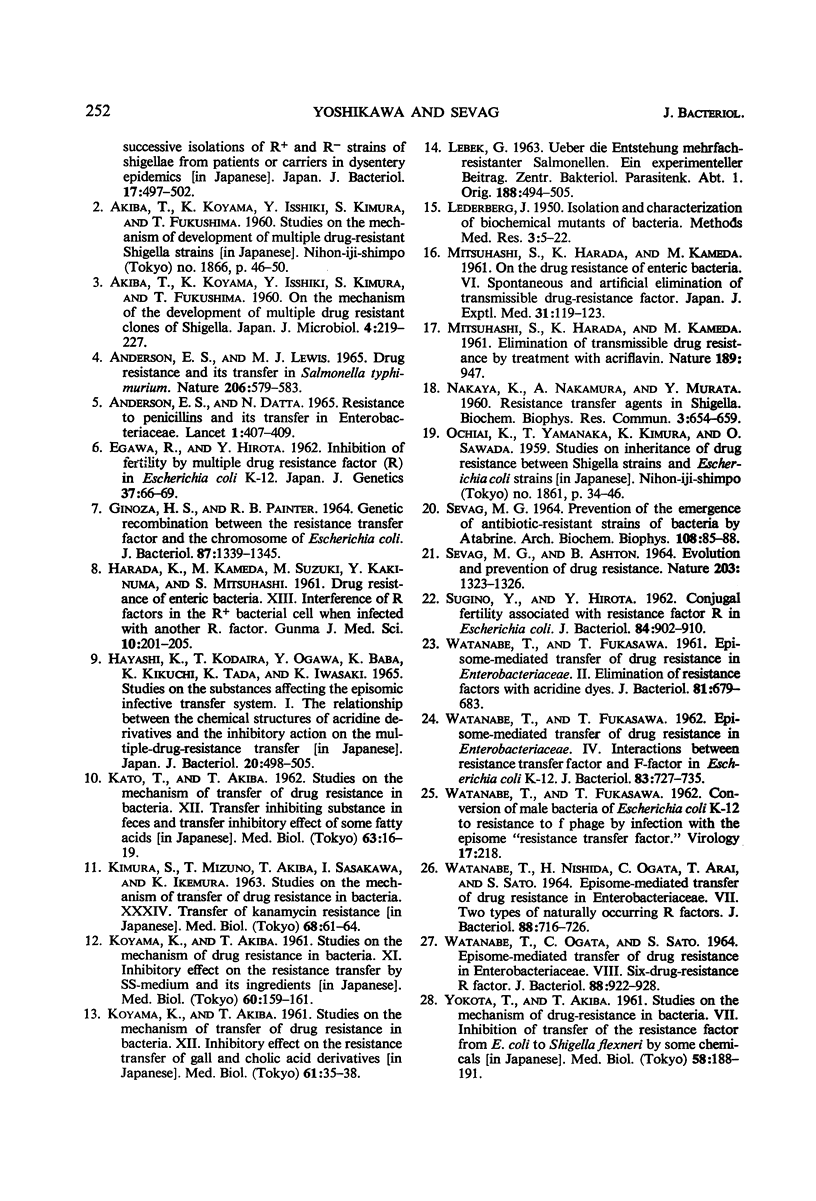
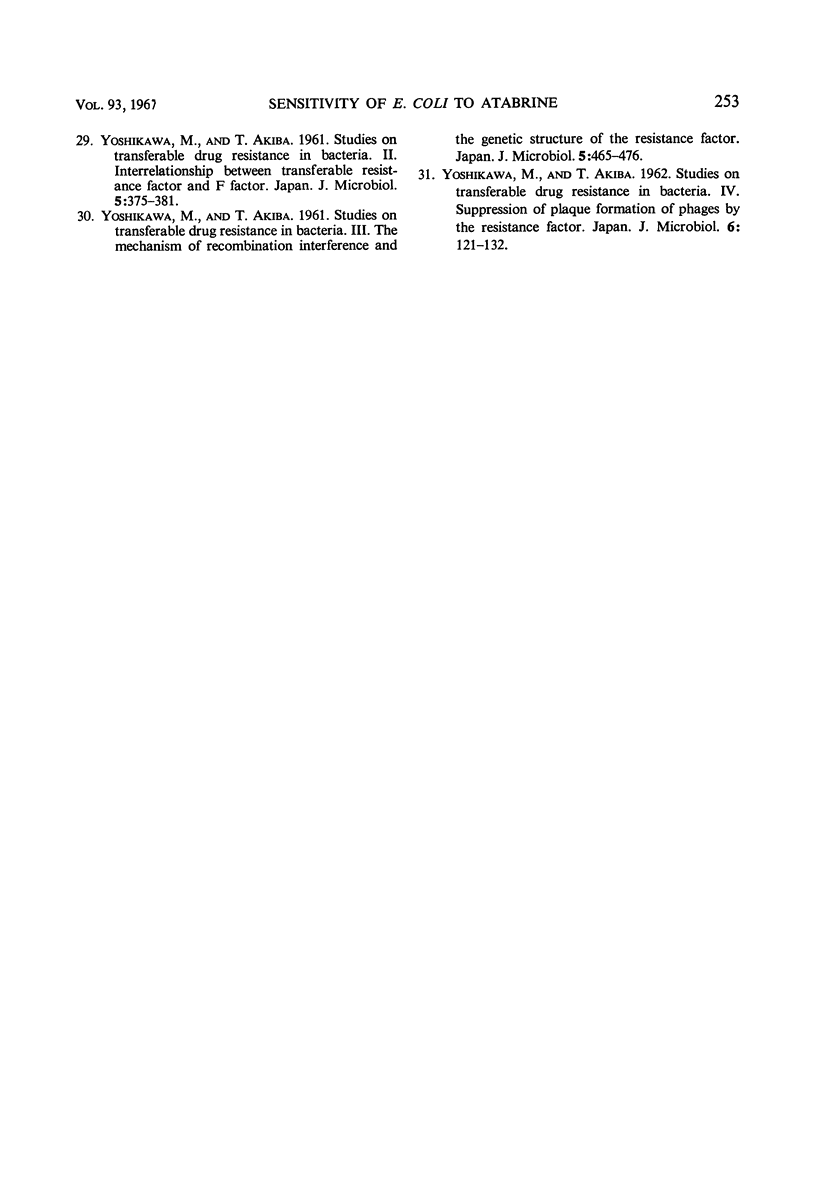
Selected References
These references are in PubMed. This may not be the complete list of references from this article.
- AKIBA T., KOYAMA K., ISHIKI Y., KIMURA S., FUKUSHIMA T. On the mechanism of the development of multiple-drug-resistant clones of Shigella. Jpn J Microbiol. 1960 Apr;4:219–227. doi: 10.1111/j.1348-0421.1960.tb00170.x. [DOI] [PubMed] [Google Scholar]
- ANDERSON E. S., DATTA N. RESISTANCE TO PENICILLINS AND ITS TRANSFER IN ENTEROBACTERIACEAE. Lancet. 1965 Feb 20;1(7382):407–409. doi: 10.1016/s0140-6736(65)90004-8. [DOI] [PubMed] [Google Scholar]
- Anderson E. S., Lewis M. J. Drug resistance and its transfer in Salmonella typhimurium. Nature. 1965 May 8;206(984):579–583. doi: 10.1038/206579a0. [DOI] [PubMed] [Google Scholar]
- GINOZA H. S., PAINTER R. B. GENETIC RECOMBINATION BETWEEN THE RESISTANCE TRANSFER FACTOR AND THE CHROMOSOME OF ESCHIERICHIA COLI. J Bacteriol. 1964 Jun;87:1339–1345. doi: 10.1128/jb.87.6.1339-1345.1964. [DOI] [PMC free article] [PubMed] [Google Scholar]
- Hayashi K., Kodaira T., Ogawa Y., Baba K., Kikuchi K., Tada K., Iwasaki K. [Studies on the substances affecting the episomic infective transfer system. I. The relationship between the chemical structures of acridine derivatives and the inhibitory action on the multiple-drug-resistance transfer]. Nihon Saikingaku Zasshi. 1965 Aug;20(8):498–505. [PubMed] [Google Scholar]
- MITSUHASHI S., HARADA K., KAMEDA M. Elimination of transmissible drug-resistance by treatment with acriflavin. Nature. 1961 Mar 18;189:947–947. doi: 10.1038/189947a0. [DOI] [PubMed] [Google Scholar]
- MITSUHASHI S., HARADA K., KAMEDA M. On the drug-resistance of enteric bacteria. 6. Spontaneous and artificial elimination of transmissible drug-resistance factors. Jpn J Exp Med. 1961 Apr;31:119–123. [PubMed] [Google Scholar]
- NAKAYA R., NAKAMURA A., MURATA Y. Resistance transfer agents in Shigella. Biochem Biophys Res Commun. 1960 Dec;3:654–659. doi: 10.1016/0006-291x(60)90081-4. [DOI] [PubMed] [Google Scholar]
- SEVAG M. G., ASHTON B. EVOLUTION AND PREVENTION OF DRUG-RESISTANCE. Nature. 1964 Sep 26;203:1323–1326. doi: 10.1038/2031323a0. [DOI] [PubMed] [Google Scholar]
- SEVAG M. G. PREVENTION OF THE EMERGENCE OF ANTIBIOTIC-RESISTANT STRAINS OF BACTERIA BY ATABRINE. Arch Biochem Biophys. 1964 Oct;108:85–88. doi: 10.1016/0003-9861(64)90358-3. [DOI] [PubMed] [Google Scholar]
- SUGINO Y., HIROTA Y. Conjugal fertility associated with resistance factor R in Escherichia coli. J Bacteriol. 1962 Nov;84:902–910. doi: 10.1128/jb.84.5.902-910.1962. [DOI] [PMC free article] [PubMed] [Google Scholar]
- WATANABE T., FUKASAWA T. Episome-mediated transfer of drug resistance in Enterobacteriaceae IV. Interactions between resistance transfer factor and F-factor in Escherichia coli K-12. J Bacteriol. 1962 Apr;83:727–735. doi: 10.1128/jb.83.4.727-735.1962. [DOI] [PMC free article] [PubMed] [Google Scholar]
- WATANABE T., FUKASAWA T. Episome-mediated transfer of drug resistance in Enterobacteriaceae. II. Elimination of resistance factors with acridine dyes. J Bacteriol. 1961 May;81:679–683. doi: 10.1128/jb.81.5.679-683.1961. [DOI] [PMC free article] [PubMed] [Google Scholar]
- WATANABE T., NISHIDA H., OGATA C., ARAI T., SATO S. EPISOME-MEDIATED TRANSFER OF DRUG RESISTANCE IN ENTEROBACTERIACEAE. VII. TWO TYPES OF NATURALLY OCCURRING R FACTORS. J Bacteriol. 1964 Sep;88:716–726. doi: 10.1128/jb.88.3.716-726.1964. [DOI] [PMC free article] [PubMed] [Google Scholar]
- WATANABE T., OGATA C., SATO S. EPISOME-MEDIATED TRANSFER OF DRUG RESISTANCE IN ENTEROBACTERIACEAE. 8. SIX-DRUG-RESISTANCE R FACTOR. J Bacteriol. 1964 Oct;88:922–928. doi: 10.1128/jb.88.4.922-928.1964. [DOI] [PMC free article] [PubMed] [Google Scholar]
- YOSHIKAWA M., AKIBA T. Studies on transferable drug resistance in bacteria. II. Interrelationship between transferable resistance factor and F factor. Jpn J Microbiol. 1961 Jul;5:375–381. doi: 10.1111/j.1348-0421.1961.tb00216.x. [DOI] [PubMed] [Google Scholar]


